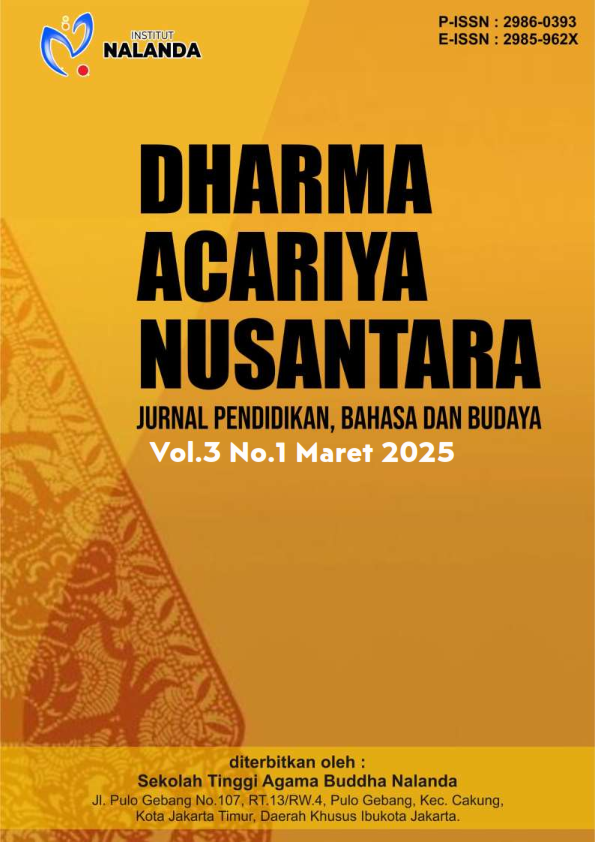Keberadaan Ritual Oke Saki pada Masyarakat Beo Kalo, Desa Lentang, Kecamatan Lelak Kabupaten Manggarai
DOI:
https://doi.org/10.47861/jdan.v3i1.1841Keywords:
Ritual, Oke Saki, Beo Kalo CommunityAbstract
Oke saki believed by the community Live If is one of the efforts or ways of the local community to erase sins or remove all mistakes made by ancestors as an effort to prevent bad luck or disaster for the next generation. RitualOke Sakicarried out from generation to generation based on local beliefs, especially community beliefsLiveRegarding supernatural powers that are still practiced today, even though currently the majority of them have embraced Catholicism. The results of this study reveal that the background of societyLiveIf you are still carrying out the ritualOke Sakinamely, the belief in legends or curses, to avoid disasters, and efforts to overcome life's problems. So that the ritualOke SakiThis is still carried out today by the communityLiveIf. RitualOke Sakiplays an important role in the survival of the local community because by carrying out ritualsOke SakiThis local community can overcome the disasters that happen to their descendants, because it is believed that if the ritual is carried outOke SakiIf this is not carried out, it will have a bad impact on their generations up to seven generations. Ritual Oke Saki which is part of the community's traditionLiveKalo is a ritual related to the elimination of sins or mistakes made by the ancestors of the local community which resulted in their descendants experiencing and bearing the sins they committed.
References
Hasbulla, N., & Jailani, M. S. (2020). Tradisi ritual Bepapai suku Banjar: Mandi tolak bala calon pengantin suku Banjar Kuala Tungkal, Provinsi Jambi Indonesia. Khazanah: Jurnal Studi Islam dan Humaniora, 18(2).
Koentjaraningrat. (1987). Pengantar ilmu antropologi. Jakarta: Aksara Baru.
Mbura, E. M. (2018). Ritual Ka Pena di Kampung Wolowuwu, Desa Tana Lo’o, Kecamatan Wolowaru, Kabupaten Ende NTT (Skripsi tidak diterbitkan). Universitas Nusa Cendana.
Moleong, L. J. (2011). Metodologi penelitian kualitatif (Edisi Revisi). Bandung: PT Remaja Rosdakarya.
Muasmar, S., & Mentari, R. (2023). Tradisi dan makna simbolik ritual Mabaca-baca dalam masyarakat Bugis di Kelurahan Ujung Tanah, Kecamatan Cenrana, Kabupaten Bone. Social Logica, 3(1).
Nuraini, S. (2020). Ritual sedekah laut dalam perspektif simbolik masyarakat pesisir Jawa Tengah. Jurnal Antropologi: Isu-Isu Sosial Budaya, 22(1), 35–44.
Prasetyo, E. R. (2019). Makna simbolik dalam tradisi Ruwatan masyarakat Jawa. Jurnal Humaniora, 31(3), 220–230.
Putra, A. Y., & Marlina, L. (2021). Simbol dan makna dalam ritual Mapalus masyarakat Minahasa. Jurnal Ilmu Sosial dan Humaniora, 10(2), 141–149.
Rahman, M. (2020). Tradisi mappacci dalam pernikahan adat Bugis: Studi semiotika budaya. Jurnal Al-Adat, 3(1), 17–28.
Ramadhan, H. A., & Fitriani, D. (2022). Representasi nilai-nilai kearifan lokal dalam ritual adat Rebo Wekasan. Jurnal Kearifan Lokal, 5(1), 58–68.
Saputra, B. (2021). Kajian makna simbolik pada tradisi Tabuik di Pariaman. Jurnal Budaya Nusantara, 8(2), 91–100.
Sianturi, I. J., & Teon, M. C. (2023). Mengakarkan nilai pertobatan Kristiani dalam ritus Oke Saki. Agama dan Kebudayaan.
Siregar, D. R. (2019). Simbolisasi dan komunikasi dalam tradisi Horja masyarakat Batak Mandailing. Jurnal Komunikasi Indonesia, 7(2), 123–134.
Spradley, J. P. (2006). Metode etnografi (M. Z. Elizabeth, Penerj.). Yogyakarta: Tiara Wacana. (Karya asli diterbitkan 1979)
Yunus, M. (2020). Tradisi ritual Paca Goya masyarakat Kaili di Sulawesi Tengah: Tinjauan antropologi budaya. Jurnal Wawasan Kebudayaan, 14(1), 51–60.













